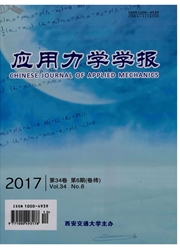

 中文摘要:
中文摘要:
偶氮染料废水中含有铬等重金属和偶氮类难降解有机物,使废水的色度大、可生物降解性低,从而形成了难处理的复合污染废水。文章研究了微波辐射下铬渣催化氧化降解甲基橙溶液中COD去除率和脱色率,探索了微波功率、微波辐射时间、pH值、铬渣用量、H2O2浓度、甲基橙浓度等对降解性能的影响,并测定了甲基橙溶液处理前后的紫外-可见光谱图。微波促进铬渣催化甲基橙溶液脱色是羟基自由基破坏偶氮键结构。有机废水中的某些过渡金属离子可作为高级氧化技术处理有机污染物降解中的催化剂,可减少化学处理药剂的使用量,降低复合污染废水的处理成本。铬渣中溶解性铬离子与H2O2形成类Fenton体系,产生羟基自由基(.OH)矿化甲基橙。利用微波加热的热效应和非热效应,能大大促进有机物的矿化速率。微波辐射能提高催化过程中H2O2的利用效率,减少氧化剂的使用量。酸性条件有利于类Fenton试剂产生羟基自由基。在微波频率2450MHz、微波功率700W、微波辐射时间3min、pH值为3、铬与H2O2的摩尔浓度比为1∶56.8的实验条件下,降解1000mg·L^-1的甲基橙溶液,其脱色率和COD去除率分别达到88%和85%。
 英文摘要:
英文摘要:
Heavy metal such as chromate compounds, together with unspent azo dyestuff, in effluent forms composite pollutants. The composite wastewater is persistent in color and nonbiodegradable. COD removal ratio and decolorization ratio of methyl orange solution were investigated by microwave -induced catalysis of Hz (32 with chromium residue. Factors governing the degradation of methyl orange were experimentally studied including microwave power, microwave irradiation time, pH value, amount of chromium residue, and concentrations of HzO2 and methyl orange solution. Results indicated that some transition metal ions might be taken as catalysts for the purification of persistent organic pollutants in organic-heavy metal wastewater treatment, which can reduce the consumption of chemicals and lower the cost of wastewater purification. Chromium ions in resi- due and Hz (32 could form Fenton-like reagent and produce hydroxyl to mineralize methyl orange. Microwave heating has both thermal and non-thermal effects, and can promote the mineralization rate of organic pollutants. Microwave can also enhance the utilization efficiency of H2O2 in the catalysis process and reduce the dosage of oxidant. The acidity is favorable for generation of hydroxyl for Fenton-like reagent. Employing chromate residue as catalyst in Fenton-like process, the decolorization ratio and COD removal ratio of aqueous MO at 1 000 mg· L^-1 were 88% and 85%, respectively, under the following conditions: microwave frequency 2 450 MHz, microwave power 700 W, microwave irradiation time 3 rain, pH 3 and molar ratio of chromium to hydrogen peroxide 1 : 56. 8.
 同期刊论文项目
同期刊论文项目
 同项目期刊论文
同项目期刊论文
 Application of the improved generalized demodulation time-frequency analysis method to multi-compone
Application of the improved generalized demodulation time-frequency analysis method to multi-compone The envelope order spectrum based on generalized demodulation time-frequency analysis and its applic
The envelope order spectrum based on generalized demodulation time-frequency analysis and its applic Application of time-frequency entropy method based on Hilbert-Huang transform to gear fault diagnosi
Application of time-frequency entropy method based on Hilbert-Huang transform to gear fault diagnosi Numerical simulation for protection scope of upper protective seam in steeply inclined multi-coal se
Numerical simulation for protection scope of upper protective seam in steeply inclined multi-coal se Mathematical Model of Coalbed Gas Flow with Klinkenberg Effects in Multi-Physical Fields and its Ana
Mathematical Model of Coalbed Gas Flow with Klinkenberg Effects in Multi-Physical Fields and its Ana The monitoring technology of geological hazards in the three gorges reservoir area and its prospects
The monitoring technology of geological hazards in the three gorges reservoir area and its prospects Micromechanical damage model for rocks and concretes subjected to coupled tensile and shear stresses
Micromechanical damage model for rocks and concretes subjected to coupled tensile and shear stresses 期刊信息
期刊信息
